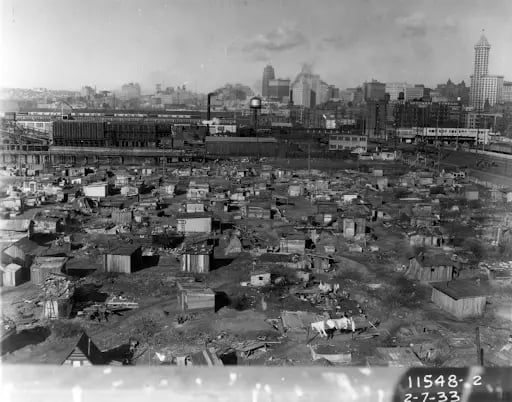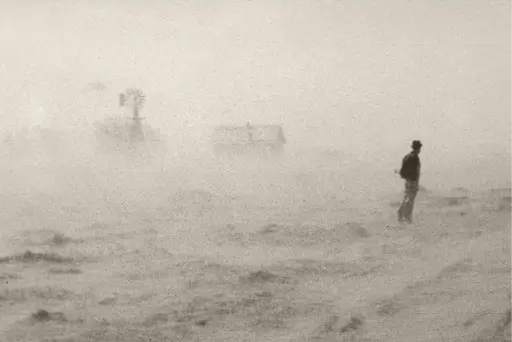What were the Social Consequences of the Crash? (Cambridge (CIE) IGCSE History): Revision Note
Exam code: 0470 & 0977
Summary
The consequences of the Wall Street Crash were felt by communities across the US. In cities, high levels of unemployment and reduced wages led to extremely difficult living conditions, evictions and home repossessions. Large areas of temporary housing, or Hoovervilles, became a feature of many American cities.
In the countryside, increased interest rates led to many farmers who had taken out loans losing their farms to the banks. In the Midwest and on the Great Plains, soil erosion, winds and drought led to farmland becoming infertile. The result was the migration of thousands of farm workers to California in search of employment.
In the South, large numbers of Black American sharecroppers were made redundant by landowners and journeyed north to try and find jobs in the cities. Recently arrived immigrants, who had already faced prejudice and discrimination, were treated even more harshly after the crash. In California, some immigrants were even deported.
Consequences for people in towns and cities
The Wall Street Crash caused many American businesses to close
As a result, unemployment rose from 3% in 1929 to 25% in 1933
The US had no social security in the 1920s
The Republican government expected unemployed workers to resolve their own problems
Charities and local governments organised social and economic support for those in need
People were forced to queue for hours for food
Such was the level of demand that some state governments went bankrupt
Government employees, such as teachers, did not receive a salary when this happened
Workers who kept their jobs still struggled because:
Their employers reduced wages and increased working hours
Bosses were able to hire someone else very easily if a worker refused to work more hours for less money
Many US citizens could not afford basic necessities
People suffered from malnutrition due to a lack of food
By 1932, over 250,000 Americans were unable to repay their mortgages
Banks repossessed houses from those who could not afford their repayments
Landlords evicted people who could not pay their rent
This led to homelessness becoming an increasing problem in many American cities
People began to create temporary housing on wasteland out of whatever materials they could find
These settlements became known as “Hoovervilles”
The name was an attack on President Hoover for his government’s failure to help people during the Depression

Consequences for people in the countryside
The economic crash caused the price of food to fall, which hit farmers’ profits
American agriculture had not benefited from the boom in the same way American industry did
During the 1920s, many farmers had borrowed money to buy machinery to make their farms more efficient
This had caused many unskilled farm labourers to lose their jobs
Between 1929 and 1933, interest rates increased, which made loan repayments more expensive
Many farmers could no longer afford the loan repayments, and 750,000 American farms were repossessed by the banks during the Great Depression
This caused many farm workers to lose their jobs
In the Midwest, the problems were intensified by soil erosion that was caused by overcultivation
In 1930, drought conditions combined with strong winds on the Great Plains to blow away the topsoil
The event, which became known as the Dust Bowl, decreased the fertility of millions of acres of farmland
As a result of these issues, many farm workers headed to the citrus farms of California in search of jobs
Life in California was tough for the migrant workers, who were often housed in large, unhygienic camps where illness quickly spread
Californian labourers also resented the arrival of so many migrant workers, as they felt the migrants were taking their jobs

Consequences for immigrants & Black Americans
In the South, many Black Americans were sharecroppers, which meant they had to give part of their crop to a landowner as rent
After the Wall Street Crash happened and the price of food fell, many landowners made the sharecroppers on their land redundant
As a result, the former sharecroppers moved to northern cities, such as Chicago and New York, in search of work
Unfortunately, job opportunities were rare in these cities, too, and the former sharecroppers faced racial discrimination
Immigrant workers faced discrimination and accusations of driving wages down
Some white American workers viewed immigrants as a threat to their jobs and resented them
In California, some immigrant workers were deported from the US and repatriated to Mexico
Worked Example
Describe the impact of the Wall Street Crash on American society in the early 1930s
[4 marks]
Answer:
The American people were affected by the Wall Street Crash because it triggered an enormous rise in homelessness. Banks began to repossess houses, as people could not afford to pay their mortgages. This caused thousands of people to create temporary housing out of cardboard and corrugated iron, called Hoovervilles.
Another impact of the Wall Street Crash on American society was its impact on agriculture. The drop in the price of food meant many sharecroppers in the South were made redundant by landowners. This led to many Black Americans from the South moving to northern cities such as Chicago and New York in search of jobs. This changed the demographics of the US.
Examiner Tips and Tricks
Using subject-specific vocabulary helps to give your answers extra authority and allows you to give more accurate and insightful answers. For example, you can use the term sharecroppers instead of farmers. Although both terms are technically correct, using the term sharecropper allows you to explain why giving a proportion of crops to a landowner in exchange for farming land left some people vulnerable when Wall Street crashed.

Unlock more, it's free!
Did this page help you?